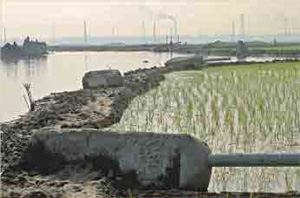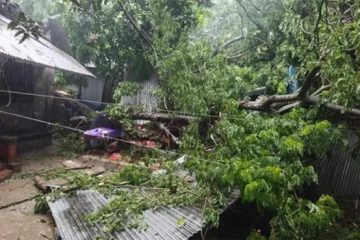Wrongly Set-up Pillars
Fresh grabbing narrows Turag
 Land grabbers have occupied a large portion of the Turag river after the Gazipur district administration “wrongly” put up boundary pillars along the dry-season waterline, excluding much of the river land.
Land grabbers have occupied a large portion of the Turag river after the Gazipur district administration “wrongly” put up boundary pillars along the dry-season waterline, excluding much of the river land.
Since the pillars were set up nine months ago, river grabbers in their dozens have been filling up the river bed and the foreshores on both sides along Tongi-Ashulia road, thus reducing the river into a canal.
The foreshore, an integral part of a river, is the soil between the low-water mark of the dry season and the high-water mark of the monsoon during normal tide. A river comprises a bed, foreshores and banks, says a High Court verdict.
But the Gazipur district administration in April this year demarcated the Turag and the Balu, excluding the foreshores despite Bangladesh Inland Water Transport Authority’s (BIWTA) plea for saving those.
Meanwhile, the district administration and BIWTA along with land officials on Monday launched a survey to include the foreshores, seven months after a ministerial committee asked for a resetting of the pillars on the basis of a foreshore map prepared in 2006.
The survey is scheduled to be completed by January 15 next year.
In line with the committee’s decision, the BIWTA and the district administration have to prepare a list of all encroachers on the floodplains, wetlands and foreshores of the rivers, and take legal action to free those.
The committee had asked to reset the pillars with high watermark during August and September but the DC said the job was not possible then, as the low-lying land of the river had gone under water.
In the meantime, the land grabbers took full advantage of the situation.
Shahjahan Siraj, assistant director of BIWTA, said the district administration had ignored the 2006 map while setting up the pillars.
“In many instances, land grabbers occupied the river further and filled it up with earth by taking advantage of the wrongly placed boundary pillars,” he told The Daily Star.
The map shows that the pillars were set up through leaving out 20 metres or more of the river land.
BIWTA officials say in many cases unoccupied foreshores too were excluded from the river, giving grabbers the opportunity to occupy them.
Resetting the pillars, however, would mean a waste of nearly Tk 1 crore in public money, an official said.
A recent visit to the river revealed that many of the pillars had been pulled up and damaged.
Earlier, the HC had ordered the deputy commissioners of Dhaka, Narayanganj, Gazipur and Munshiganj to demarcate the Buriganga, Shitalakkhya, Turag, Balu and Dhaleshwari rivers as per CS records of 1913 and RS records of 1983. It also directed the DCs to retain the eroded and newly-formed lands as part of the rivers and protect them with pillars, walkways and plantations.
Kamal Uddin Talukder, deputy commissioner of Gazipur, said the river had been demarcated not by the definition of a river and foreshore but by the CS and RS records.
Asked how the authorities would recover the river land grabbed after the setting up of the boundary pillars, he said he would place the issue before the National Taskforce on Saving Rivers to decide on it.
Syeda Rizwana Hasan, chief executive of Bangladesh Environmental Lawyers Association (Bela), said the fate of the Turag testified to the fact that massive land grabbing could not happen without the connivance of the administration.
Referring to the setting up of the boundary pillars, she said, “This is not river demarcation as per law and HC directive.”
The Daily Star on April 12 broke the news of gross anomalies in the demarcation of the rivers. Shipping Minister Shahjahan Khan launched the programme on the day.
Later, the National Taskforce on Saving River formed a special ministerial committee headed by the minister of state for land Mostafizur Rahman to look into the controversy. The committee visited the Turag and the Balu on May 20.
In its report in late May, the committee said the district administration had failed to comply with the HC order that recognised foreshores as integral parts of rivers.
The committee found many individuals and organisations had filled up the wetland adjoining the rivers and erected structures. Such illegal occupancy will lead to loss of many river areas forever unless the activity is immediately stopped.
Gazipur DC Kamal Uddin had earlier admitted to leasing out foreshore land to individuals over time. He had also said that reclaiming all the foreshores would require a cancellation of private ownerships.
Interestingly, he denied on Monday that any foreshore land had been leased out in his district.
WASTE OF PUBLIC MONEY
The district administration undertook a Tk 1.4-crore project to set up 800 concrete pillars along the 18-km stretch of the Turag and the Balu. The Public Works Department (PWD) set up 310 pillars along the thin waterline of the Turag from Ashulia and also along a part of the Balu.
The pillars already set up will be of no use when pulled out, said an engineer of the PWD.
Courtesy of The Daily Star




















